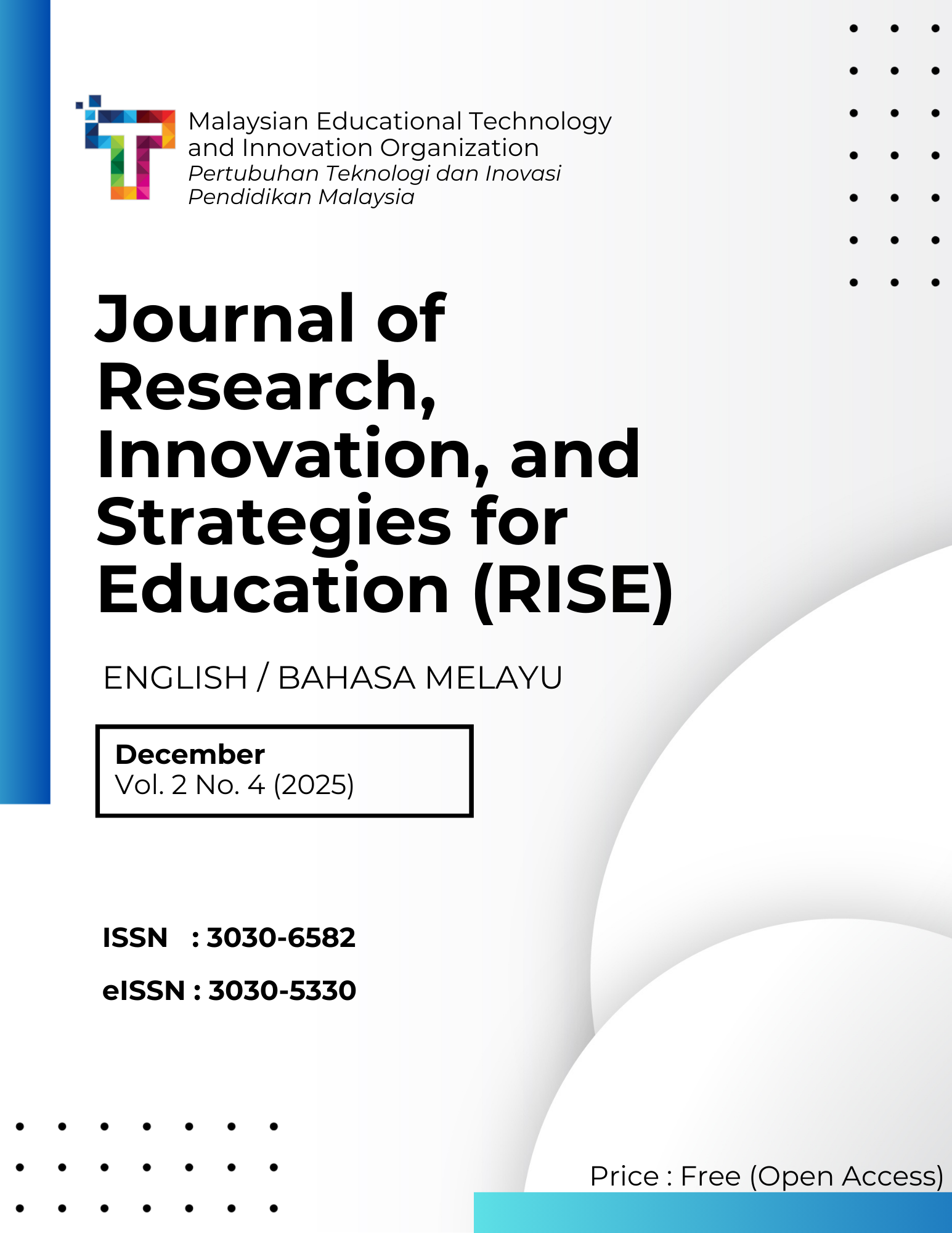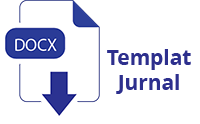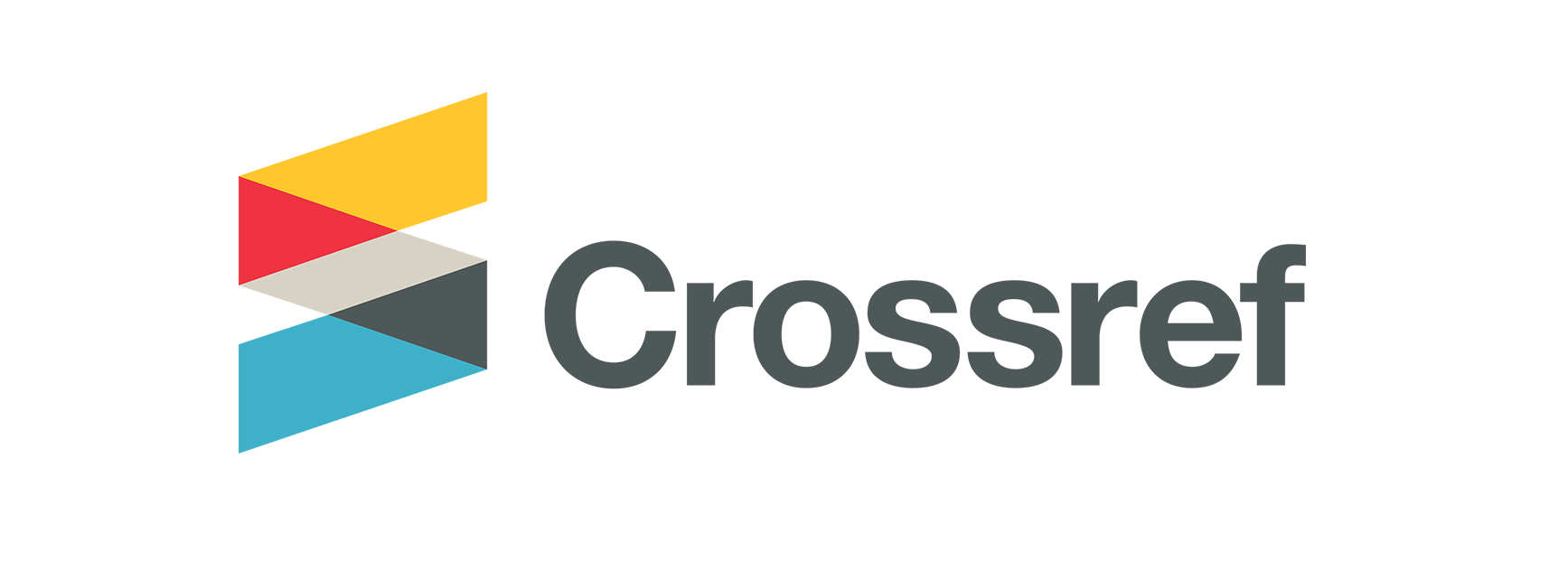Immersive Technologies in Deaf and Hard of Hearing (DHH) Mathematics Education: Narratives from Augmented Reality to the Metaverse
DOI:
https://doi.org/10.70148/rise.v2i4.5Keywords:
immersive technology; augmented reality; metaverse; mathematics; deaf and hard of hearing (DHH)Abstract
This narrative review critically examines the role of immersive technologies, including augmented reality (AR), virtual reality (VR), mixed reality (MR), and the metaverse, in enhancing mathematics learning for Deaf and Hard-of-Hearing (DHH) students. These learners often encounter challenges such as limited communication access, restricted academic sign language vocabulary, and difficulties in understanding abstract concepts, which contribute to persistent achievement gaps and mathematics anxiety. Immersive technologies provide new opportunities through three-dimensional visualization, manipulation of virtual objects, and avatar-based interactivity that can enrich comprehension and engagement. This review adopts a narrative approach to synthesize evidence from multiple disciplines, including education, psychology, information technology, and computer science. The focus is on studies retrieved from major databases such as Scopus, Web of Science, IEEE Xplore, Semantic Scholar, and Google Scholar, along with other sources related to mathematics and DHH learners. The findings indicate that AR, VR, and MR are effective in visualizing mathematical concepts and strengthening spatial reasoning, while the metaverse extends these affordances by enabling collaborative learning, social presence, and accessibility features such as captions and sign-language avatars. Nevertheless, challenges remain, including the high cost of devices, uneven infrastructure, limited teacher readiness, and inconsistent accessibility design. This review emphasizes the need for large-scale longitudinal studies, the development of Universal Design for Learning (UDL)-based frameworks, and cost-effectiveness evaluations to ensure that the integration of immersive technologies is inclusive, sustainable, and effective in mathematics education for DHH learners.
References
Aboud, Y. Z., & Al Ali, R. (2025). Bridging the Gap: Augmented Reality for Math Education among Saudi Deaf Students. Decision Making: Applications in Management and Engineering, 348-363. https://doi.org/10.31181/dmame8120251369
Achten, H. (2021). A concise history of VR/AR in architecture. In Virtual Aesthetics in Architecture (pp. 3-9). Routledge. https://doi.org/10.4324/9781003183105-2
Aftab, D. M. J., Farooq, M. A., & Khan, M. A. (2022). Challenges Faced by Teachers in Teaching Mathematics to Students with Hearing Impairment. VFAST Transactions on Education and Social Sciences, 10(3), 36–46. https://doi.org/10.21015/vtess.v10i3.946
Aguayo, C., & Eames, C. (2023). Using mixed reality (XR) immersive learning to enhance environmental education. The Journal of Environmental Education, 54(1), 58-71. https://doi.org/10.1080/00958964.2022.2152410
Ahmad, S., Umirzakova, S., Mujtaba, G., Amin, M. S., & Whangbo, T. (2023). Education 5.0: requirements, enabling technologies, and future directions. arXiv preprint arXiv:2307.15846.
https://doi.org/10.48550/arXiv.2307.15846
Al-kfairy, M., Alfandi, O., & Khaddaj, S. (2025). Psychological barriers to metaverse-based education: examining the impact of technophobia and digital fatigue. Journal of Information, Communication and Ethics in Society. https://doi.org/10.1108/JICES-04-2025-0080
Al-Nawaiseh, S. (2025). The effectiveness of augmented reality technology (metaverse) on mathematics achievement among students with learning difficulties. Jordan Journal of Applied Science-Humanities Series, 42(1), 7. https://doi.org/10.35192/jjoas-h.v42i1.1017
Andriyani, A., Buliali, J. L., & Pramudya, Y. (2022, July). The effectiveness application of learning model with augmented Reality on deaf student's geometry learning outcomes. In AIP Conference Proceedings (Vol. 2479, No. 1). AIP Publishing. https://doi.org/10.1063/5.0099940
Arici, F., Yildirim, P., Caliklar, Ş., & Yilmaz, R. M. (2019). Research trends in the use of augmented reality in science education: Content and bibliometric mapping analysis. Computers & education, 142, 103647. https://doi.org/10.1016/j.compedu.2019.103647
Arif, Y. M., & Hayati, H. N. (2022). Learning material selection for metaverse-based mathematics pedagogy media using multi-criteria recommender system. International Journal of Intelligent Engineering and Systems, 15(6), 541-551. https://doi.org/10.22266/ijies2022.1231.48
Atış, D., & Doğaner, E. Ş. (2022). Uzaktan Eğitim Sürecinde İşitme Engelli Öğrencilere Matematik Öğretimi: Türkiye–Romanya Örneği. ODÜSOBİAD, 12(3), 1845–1866. https://doi.org/10.48146/odusobiad.1100772
Austermann, C., Blanckenburg, F., Blanckenburg, K., & Utesch, T. (2025, June). Exploring the impact of virtual reality on presence: findings from a classroom experiment. In Frontiers in Education (Vol. 10, p. 1560626). Frontiers Media SA. https://doi.org/10.3389/feduc.2025.1560626
Ball, M. (2022). The metaverse: and how it will revolutionize everything. Liveright Publishing.
Basigi, et al. (2024). Supporting inference-making in school-aged deaf and hard-of-hearing children. Journal of Deaf Studies and Deaf Education, 29(2), 290–291. https://doi.org/10.1093/deafed/enae004
Baxter, G., & Hainey, T. (2023). Using immersive technologies to enhance the student learning experience. Interactive Technology and Smart Education, 20(3), 345–366. https://doi.org/10.1108/ITSE-05-2023-0078
Bazargani, J., Sadeghi-Niaraki, A., & Choi, S. (2025). A Survey and Framework for Education in the Metaverse. IEEE Access, 13, 33231-33245. https://doi.org/10.1109/ACCESS.2025.3543496.
Beck, D., Morgado, L., & O'Shea, P. (2024). Educational Practices and Strategies With Immersive Learning Environments: Mapping of Reviews for Using the Metaverse. IEEE Transactions on Learning Technologies, 17, 319-341. https://doi.org/10.1109/TLT.2023.3243946.
Boots, B., Berg, D., Hewitt, E., Naugle, K., & Naugle, K. (2025). Physical Activity and Enjoyment in Active Virtual Reality Games in Youth: Comparative Analysis of Gorilla Tag and Beat Saber. JMIR Serious Games, 13(1), e66593. https://doi.org/10.2196/66593
Britt, A. (2008, August 8). On language: Avatar. The New York Times Magazine.ball
Büyüközkan, G., & Mukul, E. (2024). Metaverse-based education: Literature review and a proposed framework. Interactive Learning Environments, 32(10), 7468–7496. https://doi.org/10.1080/10494820.2024.2324322
Casimiro, C., Neves, J. C., & Sousa, C. (2023, October). Mathematics and sign language learning with a tangible game: An inclusive approach for DHH and hearing children. In Proceedings of the 17th European Conference on Games Based Learning, ECGBL 2023 (pp. 621-631). Dechema eV. https://doi.org/10.34190/ecgbl.17.1.1411
Creed, C., Al-Kalbani, M., Theil, A., Sarcar, S., & Williams, I. (2024). Inclusive AR/VR: accessibility barriers for immersive technologies. Universal Access in the Information Society, 23(1), 59-73. https://doi.org/10.1007/s10209-023-00969-0
Darmawan, C., Ervandi, A. J., Hatip, A., & Tobing, V. M. T. L. (2025). The Effect of Using Minecraft: Education Edition on Students' Conceptual Understanding and Collaboration. Jurnal Ilmu Pendidikan (JIP) STKIP Kusuma Negara, 17(1), 186-196. https://doi.org/10.37640/jip.v17i1.2374
De Felice, F., Petrillo, A., Iovine, G., Salzano, C., & Baffo, I. (2023). How does the metaverse shape education? A systematic literature review. Applied Sciences, 13(9), 5682. https://doi.org/10.3390/app13095682
Dwivedi, Y. K., Hughes, L., Baabdullah, A. M., Ribeiro-Navarrete, S., Giannakis, M., Al-Debei, M. M., ... & Wamba, S. F. (2022). Metaverse beyond the hype: Multidisciplinary perspectives on emerging challenges, opportunities, and agenda for research, practice and policy. International journal of information management, 66, 102542. https://doi.org/10.1016/j.ijinfomgt.2022.102542
Deb, S., Surakshaa & Bhattacharya, P. (2018). Augmented Sign Language Modeling (ASLM) with interaction design on smartphone-an assistive learning and communication tool for inclusive classroom. Procedia Computer Science, 125, 492-500. https://doi.org/10.1016/j.procs.2017.12.064
Egger, J., Gsaxner, C., Kleesiek, J., & Puladi, B. (2024). What is diminished Virtuality? A directional and layer-based taxonomy for the reality-virtuality Continuum. JMIR XR and Spatial Computing (JMXR), 1(1), e52904. https://doi.org/10.2196/52904
Elena-Bucea, A., Cruz-Jesus, F., Oliveira, T., & Coelho, P. S. (2021). Assessing the role of age, education, gender and income on the digital divide: Evidence for the European Union. Information Systems Frontiers, 23(4), 1007-1021. https://doi.org/10.1007/s10796-020-10012-9
Elfanda, B. P., Wahyudi, A., Fitriana, E., & Lestari, S. T. (2025). Penerapan Media Pembelajaran Geografi Pada Materi Hidrosfer Berbasis Spatial. io untuk Meningkatkan Kemampuan Berpikir Kritis Siswa Kelas X-1 di SMAN 1 Lawang. Cetta: Jurnal Ilmu Pendidikan, 8(4), 257-269. https://doi.org/10.37329/cetta.v8i4.4533
Elsayed, M., & Abdo, S. (2023). Applications of Artificial Intelligence and Their Relationship to Spatial Thinking and Academic Emotions Towards Mathematics: Perspectives from Educational Supervisors. Eurasian Journal of Educational Research (EJER), (107). https://doi.org/10.14689/ejer.2023.107.019
Fernandes, N., & Casteleiro-Pitrez, J. (2023). Augmented reality in Portuguese museums: A grounded theory study on the museum professionals’ perspectives. Multimodal Technologies and Interaction, 7(9), 87. https://doi.org/10.3390/mti7090087
Ferrari, R. Writing narrative style literature reviews. Med. Writ. 2015, 24, 230–235. https://doi.org/10.1179/2047480615Z.000000000329
Gencer, G., Şensoy, N., & Gencer, K. (2025). Problem-based Learning in the Metaverse Environment: Evaluation of Virtual Reality Applications in Medical Education. Journal of Learning and Teaching in Digital Age, 10(2), 109-121. https://doi.org/10.53850/joltida.1521626
Gianotti, M., Marini, M. C., Beccaluva, E. A., Marulli, M. M., De Meis, I., Tomaiuoli, D., & Garzotto, F. (2024, May). Multisensory Training Intervention for Hearing Impaired Children: Preliminary Results of a Pilot Study. In Extended Abstracts of the CHI Conference on Human Factors in Computing Systems (pp. 1-7). https://doi.org/10.1145/3613905.3650734
Gradini, E., Umar, A., Firmansyah, F., Effendi, Y., & Winardi, W. (2024). Fostering Higher Order Thinking Skills in Mathematics Learning: A Scoping Review of Teacher Development Initiatives. Unram Journal of Community Service, 5(1), 9-14. https://doi.org/10.29303/ujcs.v5i1.570
Greenhalgh, T.; Thorne, S.; Malterud, K. Time to challenge the spurious hierarchy of systematic over narrative reviews? Eur. J. Clin. Investig. 2018, 48, e12931. https://doi.org/10.1111/eci.12931
Guspian, I., Noviyanti, I., & Aryansyah, A. F. (2024). Analisis Perkembangan Teknologi dan Tren Terkini Pada Platform Metaverse dalam Pendidikan: Perspektif Manajerial. Jurnal Riset Dan Inovasi Pembelajaran, 4(3), 1697-1714. https://doi.org/10.51574/jrip.v4i3.2059
Haratua, C. S., Lestari, A., Abdul, R. C., Haryanti, W. D., Suratno, S., & Ardiansyah, T. (2025). Peran matematika dan ilmu pengetahuan alam dalam menghadapi tantangan SDM di society 5.0. JIIP-Jurnal Ilmiah Ilmu Pendidikan, 8(1), 218-224. https://doi.org/10.54371/jiip.v8i1.6635
Hidayati, A., Pratama, A., Maulana, A., Primanda, D., & Hariyanto, N. (2024). Optimization Of Metaverse Technology For Immersive Learning Using The Spatial. Io Platform. In Proceeding Al GhazalI International Conference (Vol. 2, pp. 547-554). https://doi.org/10.52802/aicp.v1i1.1366
Hollerer, T., & Schmalstieg, D. (2016). Introduction to augmented reality. Augmented Reality: Principles and Practice. https://doi.org/10.1109/ISMAR-Adjunct.2016.0015
Jain, P., Kaur, K., & Porcu, L. (2025). Augmented Reality and Its Applications in the Virtual World: A Bibliometric Analysis Framework of Two Decades (2003–2023). https://doi.org/10.1108/978-1-83708-724-220251003
Krasavina, Y. V., Ponomarenko, E. P., Shishkina, A. A., & Gareev, A. A. (2023). Learning experiences of deaf and hard-of-hearing students in digital media: a literature review. Перспективы науки и образования, (6 (66)), 317-331.
Kementerian Pendidikan Malaysia, (2023) Dasar Pendidikan Digital. Documentation. Kementerian Pendidikan Malaysia.
Kritzer, K. L. (2009). Barely started and already left behind: A descriptive analysis of the mathematics ability demonstrated by young deaf children. Journal of Deaf Studies and Deaf Education, 14(4), 409–421. https://doi.org/10.1093/deafed/enp015
Lampropoulos, G., & Kinshuk. (2024). Virtual reality and gamification in education: a systematic review. Educational technology research and development, 72(3), 1691-1785.https://doi.org/10.1007/s11423-024-10351-3. https://doi.org/10.1007/s11423-024-10351-3
Lucia, B., Vetter, M. A., & Adubofour, I. K. (2025). Behold the metaverse: Facebook’s Meta imaginary and the circulation of elite discourse. new media & society, 27(2), 790-807. https://doi.org/10.1177/14614448231184249
Maas, M. J., & Hughes, J. M. (2020). Virtual, augmented and mixed reality in K–12 education: A review of the literature. Technology, Pedagogy and Education, 29(2), 231-249. https://doi.org/10.1080/1475939X.2020.1737210
Mallek, F., Mazhar, T., Shah, S., Ghadi, Y., & Hamam, H. (2024). A review on cultivating effective learning: synthesizing educational theories and virtual reality for enhanced educational experiences. PeerJ Computer Science, 10. https://doi.org/10.7717/peerj-cs.2000
Marougkas, A., Troussas, C., Krouska, A., and Sgouropoulou, C. (2023). Virtual reality in education: a review of learning theories approaches and methodologies for the last decade. Electronics. 12, 32832. https://doi.org/10.3390/electronics12132832
Mikropoulos, T. A. (2006). Presence: a unique characteristic in educational virtual environments. Virtual Real. 10, 197–206. https://doi.org/10.1007/s10055-006-0039-1
Milgram, P., & Kishino, F. (1994). Taxonomy of Mixed Reality Visual Displays. IEICE Transactions on Information and Systems, E77, 1321-1329. https://doi.org/10.1.1.102.4646
Milgram, P., Takemura, H., Utsumi, A., & Kishino, F. (1995, December). Augmented reality: A class of displays on the reality-virtuality continuum. In Telemanipulator and telepresence technologies (Vol. 2351, pp. 282-292). Spie. https://doi.org/10.1117/12.197321
Ministry of Science, Technology and Innovation Malaysia [MOSTI]. 2024. Mitoworld. MySTI. https://mysti.gov.my/product/mitoworld-3
Mishra, A., Walker, K., Oshiro, B., Langdon, C., & Coppola, M. (2022). Mathematics anxiety in deaf, hard of hearing, and hearing college students. Annals of the New York Academy of Sciences, 1513(1), 89–107. https://doi.org/10.1111/nyas.14854
Mohd Salleh, M. I., Ibrahim, Z., Othman, K. I., Yusoff, H., & Ariffin, S. (2020). Educator acceptance of Education 5.0@ UiTM framework and initiatives: a descriptive analysis/Mohd Idzwan Mohd Salleh...[et al.]. International Journal of e-Learning and Higher Education (IJELHE), 12(1), 99-108. https://ir.uitm.edu.my/id/eprint/65919
Molloy, C., & Farrell, R. (2024). Cultivating positive classroom environments: Exploring the efficacy of immersive technologies in removing barriers to learning among primary school students. Computers in the Schools, 41(2), 164-192. https://doi.org/10.1080/07380569.2024.2325441
Mulati, Y. (2023). Analisis penggunaan teknologi Metaverse terhadap pembentukan memori pada proses belajar. Ideguru: Jurnal Karya Ilmiah Guru, 8(2), 120-128. https://doi.org/10.51169/ideguru.v8i2.480
Muruganantham, G., & Kumar, B. D. (2024). Augmented Reality: Shaping the Metaverse. In The Metaverse Dilemma: Challenges and Opportunities for Business and Society (pp. 33-52). Emerald Publishing Limited. https://doi.org/10.1108/978-1-83797-524-220241003
Nemani, S. (2025). Barriers and Enablers to Adopting Virtual Reality in Lower Secondary STEAM Curricula. Journal of Advanced Research in Education, 4(2), 1-14. https://doi.org/10.56397/JARE.2025.03.01
Nunes, T., & Moreno, C. (2002). An intervention program for promoting deaf pupils’ achievement in mathematics. Journal of Deaf Studies and Deaf Education, 7(2), 120–133. https://doi.org/10.1093/deafed/7.2.120
Pagliaro, C. M. (2015). Instructional strategies for elementary-age deaf students: An evidence-based review. Deafness & Education International, 17(1), 5–24. https://doi.org/10.1179/1557069X14Y.0000000042
Pamungkas, M. D., Rahmawati, F., Chasanah, A. N., Hendrastuti, Z. R., Franita, Y., & Wicaksono, A. B. (2023). Identification of Mathematics Learning Media Needs for Junior High School Students with Hearing Impairment. Al-Ishlah: Jurnal Pendidikan, 15(2), 2076–2083. https://doi.org/10.35445/alishlah.v15i2.2865
Paulsen, L., Dau, S., & Davidsen, J. (2024). Designing for collaborative learning in immersive virtual reality: A systematic literature review. Virtual Reality, 28(1), 63–83. https://doi.org/10.1007/s10055-024-00975-4
Perinpasingam, P. T. S., Naidu, C. S., & Fadzil, F. A. M. Exploring Future Preservice Teachers’ Experience in Virtual Reality Role-Playing Micro-Teaching Activities using the EngageVR Platform. Innovating Education For A Better Tomorrow, 365. https://fslmjournals.taylors.edu.my/wp-content/uploads/SEARCH/SEARCH-2023-15-2/SEARCH-2023-P4-15-2.pdf
Poplin, A., Sharma, N., Siddharth, K., & Garau, C. (2025, June). Emotions Geogame: Developing a Game for Mapping Emotions and Evaluating Places. In International Conference on Computational Science and Its Applications (pp. 249-259). Cham: Springer Nature Switzerland. https://doi.org/10.1007/978-3-031-97606-3_17
Puspita, W., Syawahid, M., & Sucipto, L. (2024). Berpikir Fungsional dalam Menyelesaikan Permasalahan Matematika Materi Pola Bilangan. Jurnal Pemikiran dan Penelitian Pendidikan Matematika (JP3M), 7(1), 72-83. https://doi.org/10.36765/jp3m.v7i1.731
Rahim, R. H. A., Mohd Nizam, D. N., Mohd Naim, N. F., & Baharum, A. (2024). Immersive learning constructs for deaf and hard-of-hearing students in TVET practical skill. In 2024 International Visualization, Informatics and Technology Conference (IVIT) (pp. 192–199). IEEE. https://doi.org/10.1109/ivit62102.2024.10692890
Raza, A. (2023). Our Changing Reality: The Metaverse and the Importance of Privacy Regulations in the United States. Global Bus. L. Rev., 12, 30. https://engagedscholarship.csuohio.edu/gblr/vol12/iss1/6
Sabrina, S. (2023, 15 Mac). This M’sian startup launched a no-code platform for businesses to start their own metaverses. Vulcan Post. Retrieved 31 Ogos 2025, from https://vulcanpost.com/819891/mitoworld-metaverse-platform-virtual-tech-frontier-malaysia/
Samaradivakara, Y., Pathirage, A., Ushan, T., Sasikumar, P., Karunanayaka, K., Keppitiyagama, C., & Nanayakkara, S. (2025). Tailored Real-time AR Captioning Interface for Enhancing Learning Experience of Deaf and Hard-of-Hearing (DHH) Students. arXiv preprint arXiv:2501.02233.
https://doi.org/10.48550/arXiv.2501.02233
Schindler, M., Doderer, J. H., Simon, A. L., Schaffernicht, E., Lilienthal, A. J., & Schäfer, K. (2022). Small number enumeration processes of deaf or hard-of-hearing students: A study using eye tracking and artificial intelligence. Frontiers in Psychology, 13, 909775. https://doi.org/10.3389/fpsyg.2022.909775
Sghaier, S., Elfakki, A. O., & Alotaibi, A. A. (2022). Development of an intelligent system based on metaverse learning for students with disabilities. Frontiers in Robotics and AI, 9, 1006921. https://doi.org/10.3389/frobt.2022.1006921
Shackelford, S., Mattioli, M., Prince, J., & Marinotti, J. (2025). The Metaverse: What Everyone Needs to Know®. Oxford University Press. https://doi.org/10.1093/wentk/9780197759431.001.0001
Shahidi Hamedani, S., Aslam, S., Mundher Oraibi, B. A., Wah, Y. B., & Shahidi Hamedani, S. (2024). Transitioning towards tomorrow’s workforce: Education 5.0 in the landscape of society 5.0: A systematic literature review. Education Sciences, 14(10), 1041. https://doi.org/10.3390/educsci14101041
Shrivastava, D. V., Singh, S., Dadheech, V., & Yadav, U. (2023). Scopic Review of Existing Immersive Technology Solutions for Sign Languages in a Single Clustered Dataset for Sign Language Interpretation and Assistive/Accessible Teaching technologies for Education of the deaf and mute. Accessible Teaching technologies for Education of the deaf and mute (October 14, 2023). https://doi.org/10.2139/ssrn.4602374
Siddiqi, M. M. (2024). Future of digital education: inclusive, immersive, equitable. MediaSpace: DME Media Journal of Communication, 5(01), 8-24. https://doi.org/10.53361/dmejc.v5i01.02
Singh, M., & Sun, D. (2025). Evaluating Minecraft as a game-based metaverse platform: exploring gaming experience, social presence, and STEM outcomes. Interactive Learning Environments, 1-23. https://doi.org/10.1080/10494820.2025.2459200
Singh, M., Sun, D., & Yang, Y. (2025). Design and Implementation of Math City: An Inquiry-based Metaverse Platform for Mathematics Education. Computers and Education: Artificial Intelligence, 100462. https://doi.org/10.1080/10494820.2025.2459200
Stephenson N (2003) Snow crash: a novel. Spectra
Sukhera J. Narrative Reviews: Flexible, Rigorous, and Practical. J Grad Med Educ. 2022 Aug;14(4):414-417. https://doi.org/10.4300/JGME-D-22-00480.1
Suparman, Marasabessy, R., & Helsa, Y. (2024). Fostering spatial visualization in GeoGebra-assisted geometry lesson: A systematic review and meta-analysis. Eurasia Journal of Mathematics, Science and Technology Education, 20(9), em2509. https://doi.org/10.29333/ejmste/15170
Susilana, R., Dewi, L., & Rullyana, G. (2024). Exploring Student Perceptions of Virtual Learning Experiences: A Study of the Use of the Spatial. io 3D Metaverse Platform. Journal of Education Technology, 8(4), 673-683. https://doi.org/10.23887/jet.v8i4.85190
Tlili, A., Huang, R., Shehata, B., Liu, D., Zhao, J., Metwally, A. H. S., ... & Burgos, D. (2022). Is Metaverse in education a blessing or a curse: a combined content and bibliometric analysis. Smart Learning Environments, 9(1), 1-31. https://doi.org/10.1186/s40561-022-00205-x
Thom, J. S., & Hallenbeck, T. (2021). Beyond words/signs: DHH learners' spatial reasoning in mathematics as embodied cognition. American Annals of the Deaf, 166(3), 378-408. https://doi.org/10.1353/aad.2021.0026
Thom, J. S., & Hallenbeck, T. (2022). Spatial reasoning in mathematics: A cross-field perspective on deaf and general education research. Deafness & Education International, 24(2), 127-159. https://doi.org/10.1080/14643154.2020.1857539
Wang, J. (2025). Promoting the application of metaverse technology in practical teaching for university: an identification and evaluation of barriers. International Journal of Human–Computer Interaction, 41(16), 9959-9977. https://doi.org/10.23887/jet.v8i4.85190
Wei, G. W., Leng, G. P., & Naidu, C. S. Creating a Virtual Learning Environment (VLE) Using the Engage VR Platform to Create an Immersive Virtual Presence. Innovating Education For A Better Tomorrow, 646.
Wu, X., Chen, Y., & Wu, Y. (2023). Exploration of mathematics education by metaverse technology. IEEE 12th International Conference on Educational and Information Technology, 171–177. https://doi.org/10.1109/ICEIT57125.2023.10107894
Yazdi, M. (2025). Exploring the intersection of metaverse and mathematics: A visual analysis of bibliometric networks. Journal of Digital Learning and Education, 5(2), 112–128. https://doi.org/10.xxxx/jdle.2025.xxxxx
Yeganeh, L. N., Fenty, N. S., Chen, Y., Simpson, A., & Hatami, M. (2025). The future of education: A multi-layered metaverse classroom model for immersive and inclusive learning. Future Internet, 17(2), 63. https://doi.org/10.3390/fi17020063
Yerizon , Fitrani Dwina , Nor'ain Mohd. Tajudin (2021). Improving Students' Spatial Ability with GeoGebra Software. Universal Journal of Educational Research, 9(1), 129 - 135. https://doi.org/10.13189/ujer.2021.090114
Young, C. J., Levine, S. C., & Mix, K. S. (2018). The connection between spatial and mathematical ability across development. Frontiers in Psychology, 9, Article 755. https://doi.org/10.3389/fpsyg.2018.00755
Yu, T., Yang, Z., Zhang, M., Yao, L., & Sun, X. (2025). The application of the metaverse in surgical clinical teaching: transforming medical education through immersive approaches. Frontiers in Oncology, 15, 1626680. https://doi.org/10.3389/fonc.2025.1626680
Downloads
Published
Issue
Section
License
Copyright (c) 2025 Ms Chong Ai Peng, PROFESOR TS. DR. WONG KUNG TECK, Dr. Vestly Kong Liang Soon (Author)

This work is licensed under a Creative Commons Attribution 4.0 International License.












